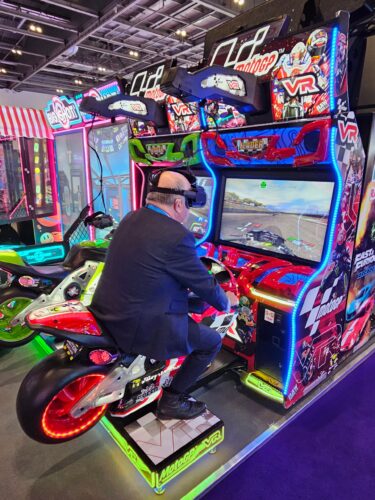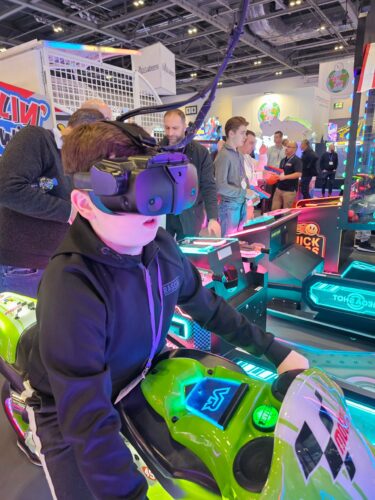Virtual Arena: VR Arcade Action

The Application of XR into the attractions and amusement landscape is covered by industry specialist Kevin Williams, in his latest Virtual Arena column – we look at the next generation of amusement deployment of VR from EAG, the first amusement trade expo of the year.
Content
In this latest column for MIXED, we take an exclusive walk down the aisles of London’s European Amusement and Games Expo (EAG 2024). The event gathers the latest generation of amusement and gaming systems for the trade and offers a great chance to see the advancements of the deployment of VR into the leisure entertainment business.
EAG offers a chance for amusement venue operators to select their next series of machines to deploy on property. The January show offers a chance to make those all important orders to be delivered in time for the beginning of the season. Being the first full-scale amusement trade event of the year, the London EAG offers a unique barometer of the trends in coin-op-based amusement.

Bild: KWP
VR has become a mainstay for many operators in the West, sitting alongside video amusement and redemption and prize machines as key facility earners. But the sector has had to compromise the deployment of this technology to meet the needs of amusement entertainment operations.
One of the fundamentals being the expense of having a member of staff man the machines – so the amusement trade has been working hard to define unattended (self operated) VR platforms. Since the first successful VR amusement systems appeared in 2017, we have seen a perfusion of applications – but 2024 marked a new generation of VR systems, what some are calling “VR 2.0”.
Style of Machine
The new generation of VR amusement pieces feeds off the theory and experiences from the older applications. Since the deployment of the evergreen Chinese 9D VR egg pods, with their passive game experiences, the amusement trade in the West has worked hard to develop a platform that offers simple player enjoyment, and a robust deployment of headset-based experiences. What have been labelled the “VR Ride” systems – two-seater systems have found popularity, (personified by LAI Games ‘Virtual Rabbids’).
At EAG 2024 we saw the previous generation of VR systems handing the torch to the new-generation. One of those that defined the market is developer Raw Thrills, who launched their ‘King Kong of Skull Island VR’ system back in 2020. At the London show the company represented by their distributor showed ‘King Kong of Skull Island II’ the latest version of the game system with new chapters. Comprising a motion platform for two riders, whose hand movements are tracked within the game to interact with the fast-paced action.
Video: KWP
This latest version of the original VR experience has also been complimented by Raw Thrills latest VR game alongside. Another big movie IP sees the launch of ‘Godzilla Kaiju Wars VR’ – again a two-player experience. But this time, the hand tracking has been replaced by mounted machine guns that the players use to spray fire across the cityscape, blasting the iconic monster and his minions.
This latest game uses the ‘Thrill-D NXT’ motion platform from the company and has been developed learning many of the lessons from the previous releases.
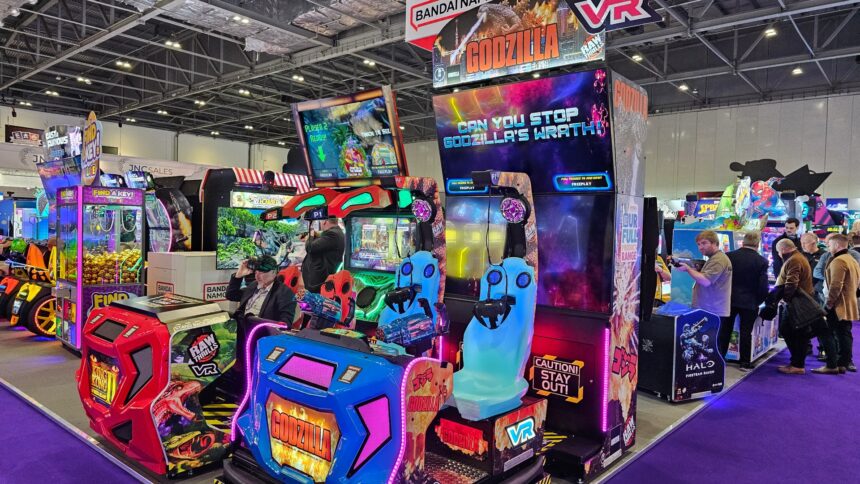
Bild: KWP
A third example of the prolific development investment made by Raw Thrills into immersive entertainment sees the VR version of their previous motorbike racing title. ‘MotoGP VR’ takes the established ride-on motorbike amusement package and deploys the visuals through a headset to offer a new level of immersion.
But still ensures that the package speaks the amusement operator’s language, incorporating much of the elements needed from convention arcade racer. These titles being represented in key territories by BANDAI NAMCO Amusement.
The principle of taking a proven video arcade formula and applying that to the latest immersive approach was also seen from developers LAI Games. The company has had great success with their fast pace street racer title, and the show marked the deployment of a VR version of the game.
With ‘Asphalt 9 Legend Arcade VR’ the racer has been given a VR presentation, with players sitting on a motion platform with wind effects. The new racer, with VR component being distributed by SEGA Amusement International.
Video: KWP
The last of the VR arcade pieces on display at EAG 2024 harkened back to the original appearance of VR into the Out-of-Home entertainment scene. On the Harry Levy booth at the show, a range of Chinese motion seat systems (called ‘VR Shark’ from Movie Power), reminiscent of the previous 9D egg VR systems, were presented.
However, these are the latest versions of this approach, benefiting from the mass sales of the previous versions. This package offers a platform for operators to dip-a-toe into the waters of operating VR.
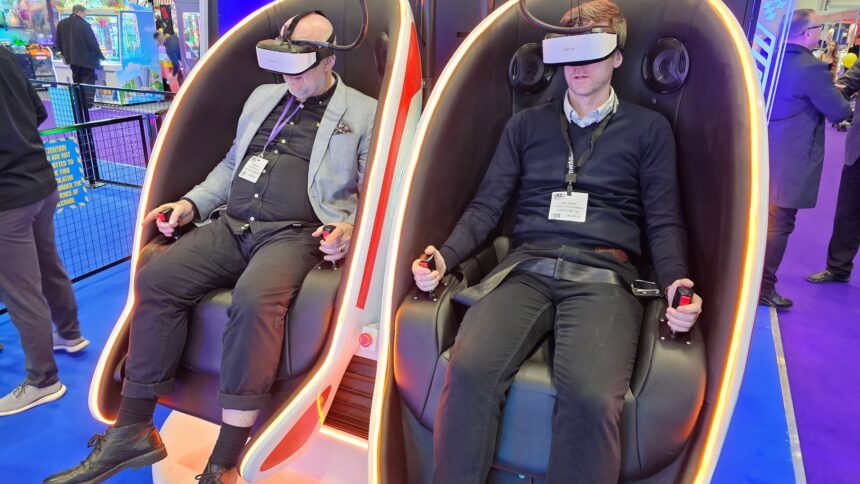
Bild: KWP
Headset Dilemma
One aspect of the rise of VR in amusement is the compelling nature of the experience. But this comes at am cost.
Many operators have found the VR systems difficult products to field in the market. The main reason is the fragility of the technology, with many systems having to be repaired in the field. This is the price of deploying consumer grade head-mounted displays on these machines, being the only available source of VR headsets. This has been compounded by the volatility of VR hardware suppliers. The case in point was self-evident from the releases on show.
One of the first providers of VR hardware for amusement had been HP, and it was seen that ‘King Kong II’ was using HP Reverb headsets, but sadly this has proven a dead end. Just as the ink was drying on several commercial entertainment agreements to deploy the HP systems in amusement and attractions, HP would make the sudden surprise decision to abandon development and discontinue their VR operations, sunsetting the Reverb line.
The HP headset had also been selected for the ‘Asphalt 9 Legends Arcade VR’ new release. The developers taking much time in perfecting a ruggedized delivery system for the headsets. Having to be able to ensure these vulnerable systems are properly protected against the rough treatment expected when deployed in an amusement venue. The price that must be paid for favoring unattended operation.
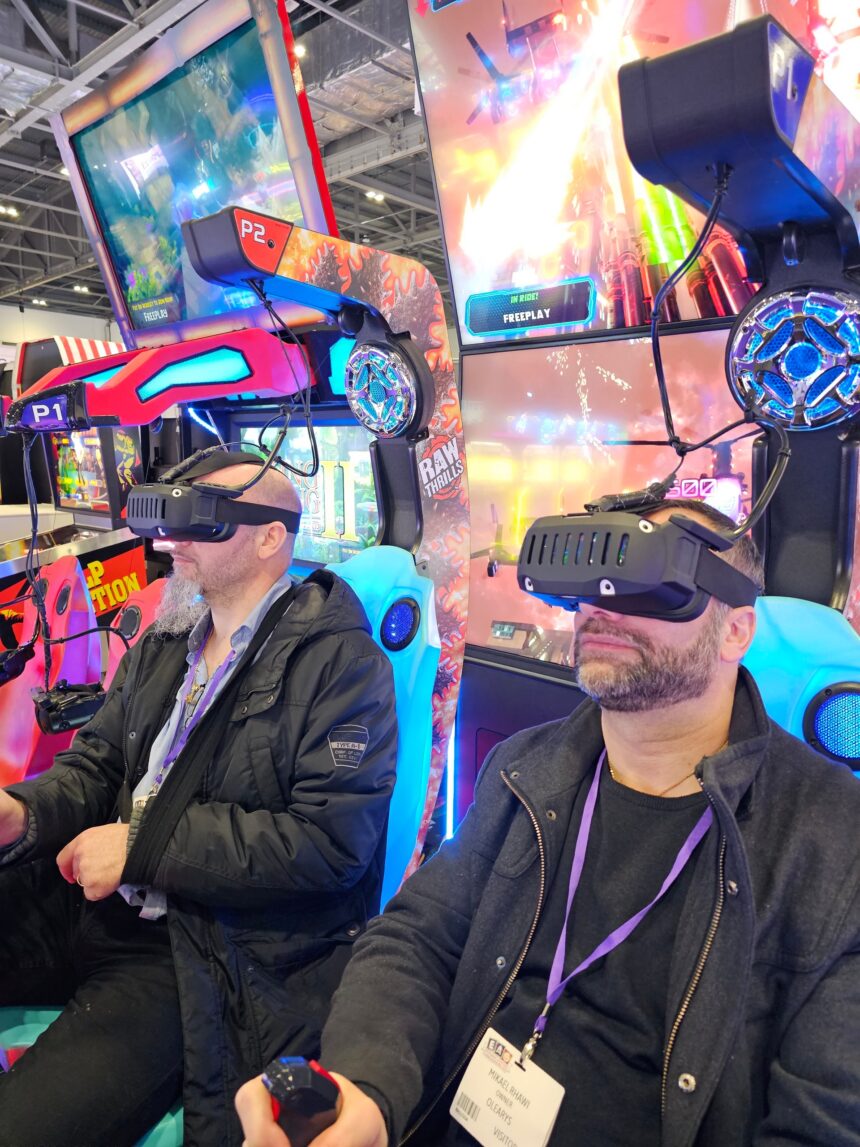
Bild: KWP
Raw Thrills would pivot from HP hardware to another VR headset provider with their latest ‘Godzilla Kaiju Wars VR’ release. Chinese manufacturer Deepoon (now branded DPVR) has been used, given a ruggedized packaging, and cable retention system of their own.
DPVR is a well-known provider of VR headsets, famous for supplying the first units that most 9D pods employed. The company has doubled down on their investment into commercial entertainment, striking partnerships in the West. At the recent CES show, the DPVR booth presented their affiliation with Raw Thrills with the Godzilla amusement piece running on their booth.
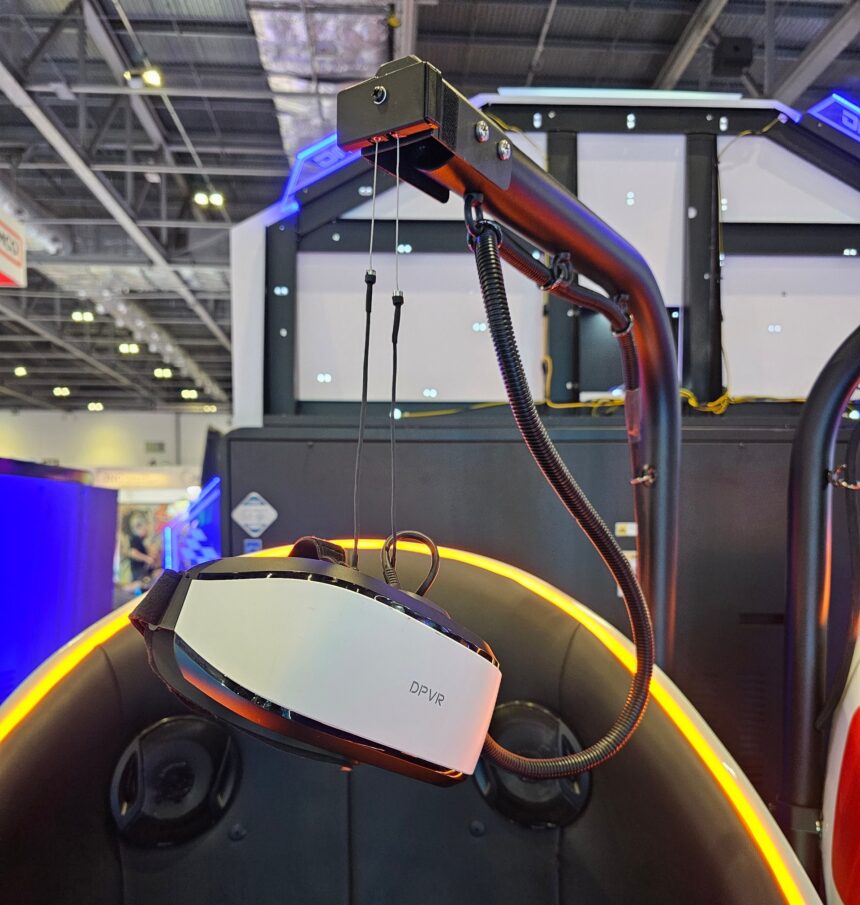
Bild: KWP
At EAG, the ‘VR Shark’ pod was using the previous range of DPVR headsets. Again, given their own weight relief system, the older style of headset showed how far the technology has advanced compared to their latest series of systems.
Much has changed in the migration to VR 2.0., where once previously the HTC VIVE headset ruled supreme in Western LBE deployment, we see now the DPVR systems starting to make inroads. Part of this is filling the vacuum left by other manufacturers. The sudden departure of HP caused much consternation, and many VR developers are concerned about the longevity of support they can expect from other hardware providers.
We have seen PICO, who also has an extensive LBE VR presence with many developers using their hardware, start to make noises of their own restructuring of support of the VR headset market. Pressured by their parent corporation, ByteDance. For a VR amusement machine developer, the danger of selecting a headset for the next release that could then be terminated at any moment, is a serious consideration. Underpinning the need to move away from consumer offerings.
Shot at the Future
Moving beyond the developments in the VR scene, gaining momentum away from the more traditional amusement configuration. We are seeing VR deployed in its own arena attractions. While no physical VR arenas were at EAG’24 this year, there was a representation from exhibitor Immersive Arena, an operation offering VR arena installations, and a sales agent for developer VR Esports from Phenomena.
These VR Arenas are an area of the market that sees HTC’s Focus 4 offering a viable solution for non-backpack VR free-roaming game experiences. And while PICO hopes to also penetrate this sector – the upheavals at the corporate level are still to be fully felt. It is this commercial business that has been the only part of the VR boom that has seen serious revenue generation, while consumer VR deployment seems to have missed expected sales targets.
Moving forward and in March 2024, the first of the American amusement and gaming trade events will take place, and it is expected that these exhibitions will be heavily populated with Virtual Arena systems. While at the same time, we expect to see a continued new investment in immersive amusement attractions. A hunger created in the guests visiting the entertainment venue space.
This concludes the snapshot of developments in the amusement VR scene. We now turn our gaze to the “Active Immersive Entertainment” market, and how immersive fitness systems could be the replacement for the troubled gym business.
Note: Links to online stores in articles can be so-called affiliate links. If you buy through this link, MIXED receives a commission from the provider. For you the price does not change.
